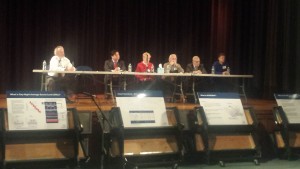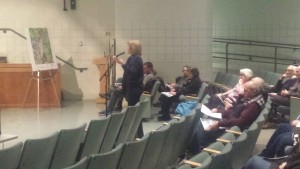WESTFIELD—Residents and city officials are still confused following another noise mitigation meeting and one official said the program may not survive.
Residents of Westfield met at the North Middle School auditorium to once again discuss the noise mitigation program with representatives from Wyle Engineering, the Federal Aviation Administration (FAA) and Barnes Regional Airport. The meeting was held after the FAA felt that too much time had elapsed since the last changes occurred to the program.

The panel at the noise mitigation meeting. From left to right: Richard Doucette, interim airport manager Adam Houghton, Jane Verbeck, Mel Bake, acoustical engineer manager Yuriy Gurovich, acoustical engineer Patrick Kester
The noise mitigation program—also known as the Noise Compatibility Program (NCP)—was designed by Wyle, in conjunction with FAA regulations and the city’s input, to lessen the impact of noise from the airport on residents, homes and businesses. The program utilizes a noise contour map, which is based on mathematical contours from the variety of noise-making vehicles on and around the airport rather than measured decibel levels, to determine what homes are at risk for noise pollution. The result is called the day-night level (DNL), and is essentially an averaged-out decibel level with additional factors put in.
This has resulted in two forms of action taken by Wyle if a home is in a contour of impact. Home acquisition, which is where they purchase the home, find comparable housing for the tenants and then demolish the home due to DNL levels of 65 and over, or sound insulation, which is where improved windows, doors, roofs and central air conditioning units are installed in the homes to reduce noise pollution present within the home due to lower levels of sound.
During the meeting, changes to the program from the 2009 version to last year’s version were outlined, followed by a question-and-answer portion in which the public was able to participate. It was during the question-and-answer portion that the residents and city councilors present voiced their concerns over the confusion that has resulted from the program’s implementation.
One such point of confusion was related to when a resident declines home acquisition—which is a voluntary program—and instead opts for sound insulation. Based on the NCP’s design, this could result in residents who are in the contour zone of higher levels to be left waiting for several years before any action is taken, as well as a possibility of a changing contour map that would leave them without any mitigation measures.
“The FAA suggests not to sound insulate until all homes for acquisition are taken care of. Whoever’s the noisiest gets taken care of first,” Richard Doucette, FAA representative, said. “If you decline acquisition you would have to wait until all other acquisitions are done before being sound-insulated, then those who declined acquisition will be put to top of the list.”
Another point of confusion stemmed from the fact that for acquisition, a home needed to be within the zones of impact of over 65 DNL to qualify, but once a homeowner declines acquisition and instead requests noise insulation, they may not qualify for the noise insulation.
Wyle senior construction engineer Melvin Baker explained that this is due to testing done at the homes to measure internal decibel levels, rather than based on the contour map.
“No testing is needed for a buyout, but if you decline it then you need to meet regulations of interior noise,” Baker said.
This interior level has to be at least 45 decibels, and homes that have certain construction standards tend to not qualify in spite of their location and the exterior noise of the home.
Another concern voiced by the public was regarding property value where homes are demolished. According to Carol Shannon, resident of Westfield and NCP opponent, property values drop when a home is demolished and a vacant lot is left.
“My house comes down, my neighbor goes to sell his home and he has a vacant lot next to his–it devalues his home,” she said.
Additionally, she claimed that the acquisition of homes is at times sporadic, which leaves some neighborhoods with occasional vacant lots in otherwise untouched neighborhoods.
In the end, Doucette claimed that due to the city being in control of the program it had different standards than other programs, such as the option for noise insulation rather than acquisition, which means that the program will be difficult to keep afloat.
“It is a very confusing program, and because it’s so unique it may not survive,” he said.
Residents are urged to contact Wyle at Barnes Regional Airport with any concerns.


